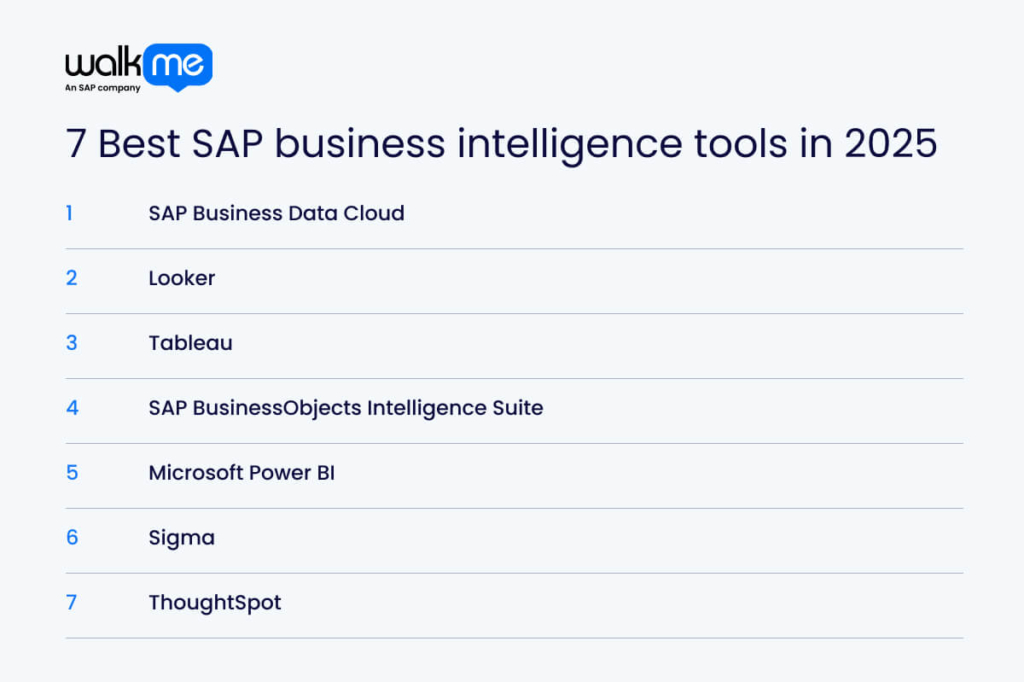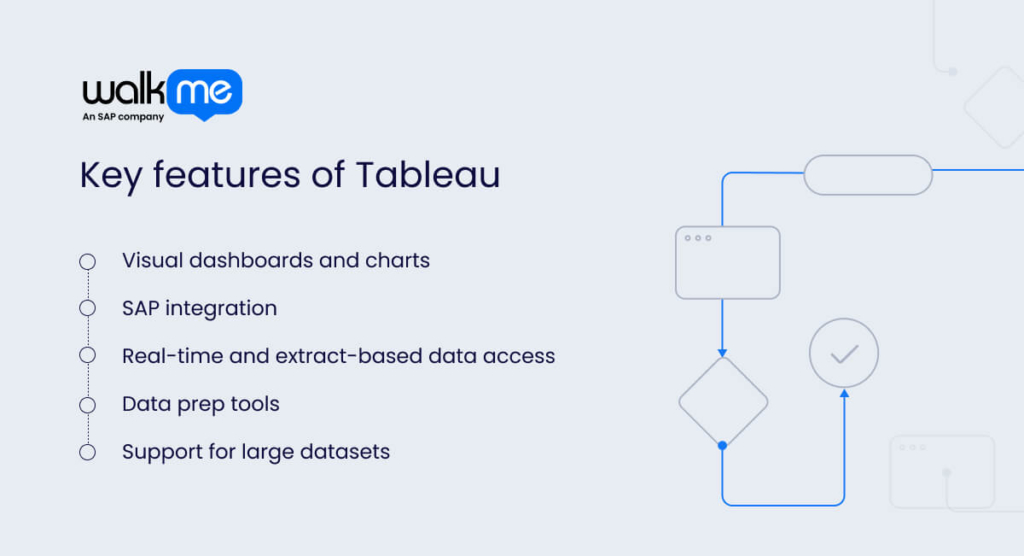Many business leaders rely on experience, instinct, and past trends to guide decisions. While these methods still hold value, the rising volume and complexity of data make them less effective on their own. Business intelligence tools, such as SAP business intelligence tools, add support by offering real-time data and clear insights.
They help leaders compare options, make faster decisions, and maintain adaptability. Instead of working with outdated or manual reports, leaders can access accurate, up-to-date information.
Choosing the right BI tool can be difficult. There are many options, features, and skill levels to consider. In this article, we list seven SAP BI tools to consider and explain how to choose the right one for your business needs.

1. SAP Business Data Cloud
Best For: Companies that already use SAP tools like SAP BW or want to connect data from different systems.
SAP Business Data Cloud operates on the SAP Business Technology Platform (BTP) and enables businesses to leverage AI across both SAP and non-SAP systems. It provides users with a central location to access and share data, facilitating more informed decisions.
Key features:
- Unified data access: This tool brings together data from cloud and on-premise sources, offering a consistent and governed way to access it.
- Simplified data models: The One Domain Model consolidates SAP application data into a single, clear system, enabling business users to access and work with it more easily.
- AI-powered decision support: Employees can benefit from AI tools that highlight risks, improve forecasting, and automate business workflows.
- Cross-platform integration: Built-in connections to platforms such as Databricks, Calibra, and Confluent enable seamless integration with both SAP and non-SAP systems.
2. Looker
Best For: Organizations with experienced data teams, especially those using Google Cloud. It empowers users across the business to explore data while keeping strong data governance in place.
Looker, now known as Looker (Google Cloud core), is a business intelligence (BI) platform that helps users explore, analyze, and share data insights. It supports both business and technical users by offering tools for data modeling, reporting, and visualization.
It connects directly to SAP systems, including SAP HANA, through the Live Data Gateway. This enables teams to analyze SAP data in real-time without copying or moving it. Looker also includes a pre-built SAP Block with ready-to-use dashboards and views to simplify SAP data integration.
Key features:
- Google Cloud integration: Looker fits well into the Google Cloud platform, making setup, scaling, and management easy.
- Live Data Gateway: Teams can access real-time data from SAP and other systems without moving or duplicating it.
- Advanced data modeling: Users can set rules for how Looker handles data relationships, filters, and calculations.
- Broad SQL dialect support: Looker connects to many databases and works with more than 50 types of SQL.
- Data governance and security: Admins can control who sees what, set access rules, and protect sensitive data.
3. Tableau
Best For: Businesses that want deeper insights beyond standard SAP reports and prefer a more interactive, visual approach to data analysis.
Tableau is a business intelligence (BI) and data visualization tool that helps users explore and understand their data through interactive dashboards, charts, and reports. It connects to many SAP systems, including SAP S/4HANA, SAP Business Warehouse, and SAP HANA. This allows teams to analyze SAP data in a more visual way, without knowing how to code.

Key features:
- Visual dashboards and charts: Employees can create detailed visualizations, such as graphs, maps, and dashboards, to make complex data easier to understand.
- SAP integration: Official support for SAP HANA and other systems includes features like single sign-on for secure, seamless access.
- Real-time and extract-based data access: Users can choose between live data connections or data extracts for better performance.
- Data prep tools: Tableau Prep helps teams clean, combine, and organize data before building visuals.
- Support for large datasets: The platform can manage large volumes of data, making it suitable for enterprise-scale analytics.
4. SAP BusinessObjects Intelligence Suite
Best For: Large enterprises that want to drive data-driven decisions with powerful reporting and analytics.
The SAP BusinessObjects Business Intelligence (BI) suite gives business users the tools to report, analyze, and visualize data from multiple sources. It connects with both SAP and non-SAP systems, helping companies build complete, unified reports.
Key features:
- Reporting and analysis: Teams can run ad-hoc queries, create reports, and build visualizations to spot trends and find key insights.
- Real-time business intelligence: Businesses can monitor live data and track key business metrics as they happen.
- Self-service analytics: Business users can explore data, build visualizations, and share findings without needing IT support.
- Role-based dashboards: You see dashboards tailored to roles, helping you focus on what matters most.
- Data governance and security: Admins define access roles, set data policies, and manage data quality to protect information.
- Predictive analytics: Employees can apply statistical models and forecasting tools to predict future trends and behavior.
- Office integration: Users embed BI reports into Microsoft Word, Excel, and PowerPoint to support presentations and documentation.
- Scalability: Organizations can support small teams or tens of thousands of users across departments and regions.
5. Microsoft Power BI
Best For: Individuals who want to build interactive dashboards that help teams make data-driven decisions based on SAP data.
Microsoft Power BI is a business intelligence (BI) tool that helps users explore and understand data from many sources, including SAP systems. Both technical and non-technical users can create reports and dashboards using its simple, drag-and-drop interface without coding. Power BI also connects to SAP through direct links to SAP HANA and SAP BW, or OData and other options.
Key features:
- Data preparation: With Power Query Editor, users can clean, filter, and transform data before using it in reports. This helps improve accuracy and saves time.
- Visual design tools: The drag-and-drop interface makes it easy to build reports and dashboards. Users can create charts, tables, and visuals without needing to write code.
- Collaboration features: Teams can share dashboards, work together on reports, and publish results to the Power BI service. This supports better teamwork and faster decision-making.
- Data connections: Power BI connects to many data sources, including SAP systems, cloud services, databases, and spreadsheets. This flexibility allows users to bring all their data into one place for analysis.
- Modeling tools: Power BI uses DAX (Data Analysis Expressions) to create custom calculations, define relationships between tables, and build measures that enhance data analysis.
6. Sigma
Best For: Non-technical users who need to run fast, live analysis on large datasets, build financial reports, or find missing journal entries.
Sigma is a cloud-based business intelligence (BI) tool that resembles a spreadsheet. It connects directly to cloud data platforms, such as Snowflake, BigQuery, and Databricks. With Sigma, users can work with live data without writing code or setting up complex data pipelines.
Teams can bring together various data sources to gain a deeper understanding of customer behavior, track forecasts, and make informed decisions. Sigma helps businesses act quickly by providing a comprehensive view of operations and customer interactions.
Key features:
- Real-time cloud data access: Sigma connects directly to cloud data warehouses, keeping data fresh without the need for an ETL tool.
- Spreadsheet-style interface: Users interact with data in a familiar, easy-to-use layout for calculations and reports.
- Integration with SAP: Sigma unifies SAP and non-SAP data for complete, cross-platform insights.
- Collaborative analytics: Multiple employees can explore, edit, and share insights together in real time.
- User-friendly for all skill levels: Teams without technical training can run analysis and build dashboards easily.
- Advanced data exploration: You can drill into details, apply filters, and run custom calculations to find key insights.
7. ThoughtSpot
Best for: Companies that want to provide more people, whether technical or non-technical, with access to data and insights.
ThoughtSpot is an AI-powered business intelligence (BI) platform that helps users explore and analyze data by asking questions in plain language. It works well with SAP systems and connects directly to SAP HANA, SAP BW, and SAP BusinessObjects.
With ThoughtSpot, users can skip the complexity of traditional SAP reporting tools and quickly find answers without needing technical skills.
Key features:
- Easy integration: ThoughtSpot connects with SAP systems, including SAP HANA, SAP BW, and SAP BusinessObjects, as well as other cloud- native platforms.
- Fast performance at scale: It handles large amounts of data from different sources while delivering quick results.
- Plain language search: Users can ask questions using everyday language to explore data without needing technical knowledge.
- Smart insights with AI: ThoughtSpot’s AI recommends relevant data, charts, and trends based on what users search for.
- Custom dashboards: All employees can build, personalize, and share dashboards that show live data.
- Wider data access: ThoughtSpot helps more people across the business access and understand data, reducing reliance on analysts.
- Collaboration tools: Teams can share findings, work on reports together, and create a strong data-driven culture.
How to choose the right SAP business intelligence tool for your enterprise
Selecting the right SAP Business Intelligence (BI) tool gives your business a distinct competitive advantage.
It transforms raw data into actionable insights, enabling you to optimize operations and respond promptly to market shifts.
Use this comparative guide to pick the best tool for your goals:
| Requirement | Tool (s) to adopt | Why it works |
| Intuitive dashboards and visual storytelling | Tableau, Power BI | Tableau can provide you with interactive visuals. Power BI integrates seamlessly with Microsoft 365, providing intuitive reporting. |
| Budget-friendly and fast deployment | Power BI, Sigma | Power BI is low-cost and integrates quickly into Microsoft environments. Sigma is easy to deploy in modern cloud warehouses. |
| Scalable cloud-native architecture | Looker, Sigma, ThoughtSpot | Looker offers central data modeling while Sigma enables spreadsheet-based modeling. ThoughtSpot supports live querying, which supports long-term growth. |
| Real-time data exploration via search or voice | ThoughtSpot, Tableau, Sigma | ThoughtSpot enables Google-like querying. Tableau supports natural language questions with ‘Ask Data.’ Sigma offers Excel-like querying, |
| Easier SAP integration & strong data governance | SAP Business Data Cloud, SAP BusinessObjects, Power BI | Best for organizations running SAP S/4HANA, ECC, BW, or other SAP modules. Offers strong governance, lineage, and semantic modeling. For instance, BusinessObjects supports structured reports with audit trails. Power BI supports paginated reports and role-based security. |
Turn unstructured data into operational insights with the right SAP business intelligence tools
SAP business intelligence tools help businesses turn messy, unstructured data into clear insights that support smarter decisions. To get the most out of these tools, your cross-functional team should choose tools that match their data needs, business goals, and level of data maturity.
Instead of trying to do everything at once, start small when implementing these tools within your current digital workflow. Focus on achieving quick wins within one or two departments to demonstrate early success and establish trust in the tools. As your overall organization grows more confident, expand the use of BI across other areas.
Leadership also plays a key role in BI success. When senior teams lead by example and support data use, they build a culture of smart, informed decision-making across the business.
FAQs
SAP Business Intelligence (BI) tools are software that help businesses understand their data. These tools enable users to collect, organize, and analyze data from various sources. They also help create reports. This enables companies to make informed decisions, enhance their operations, and stay ahead of the competition.
SAP Business Intelligence (BI) tools are essential because they enable businesses to analyze data from various sources and derive valuable insights. With this information, companies can make better decisions. These tools also help improve daily operations, boost productivity, and enable more efficient work practices, allowing organizations to stay ahead of competitors.
SAP Business Intelligence (BI) and SAP Business Analytics both facilitate data analysis, but they serve distinct purposes. BI examines past and present data to illustrate past and present trends. Business Analytics goes a step further by using that data to predict what might happen in the future. This helps businesses plan and make wise choices.
Small businesses can adopt SAP Business Intelligence (BI) tools to gain a deeper understanding of their data. This helps them make more informed decisions and enhance their day-to-day operations.

